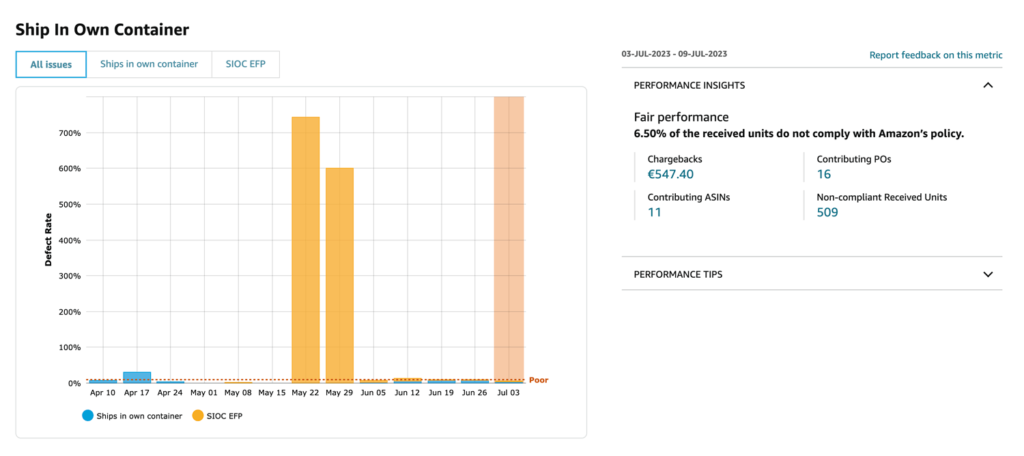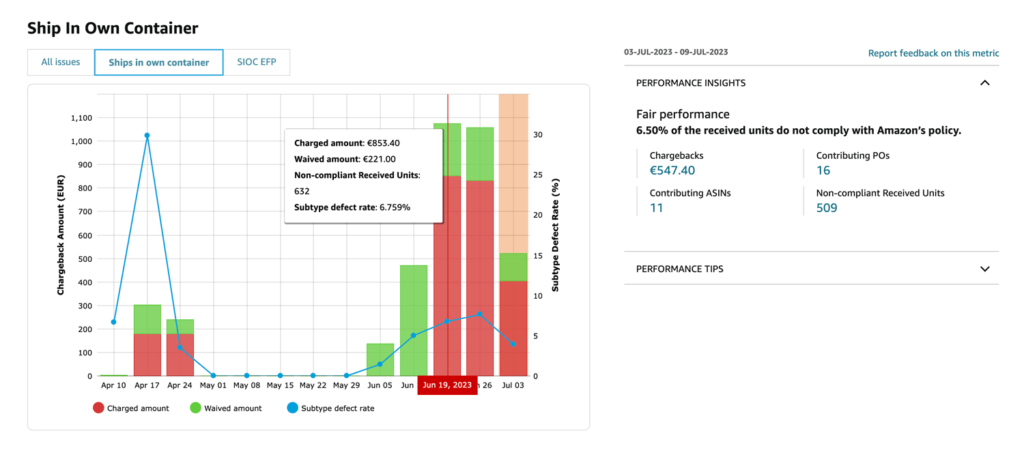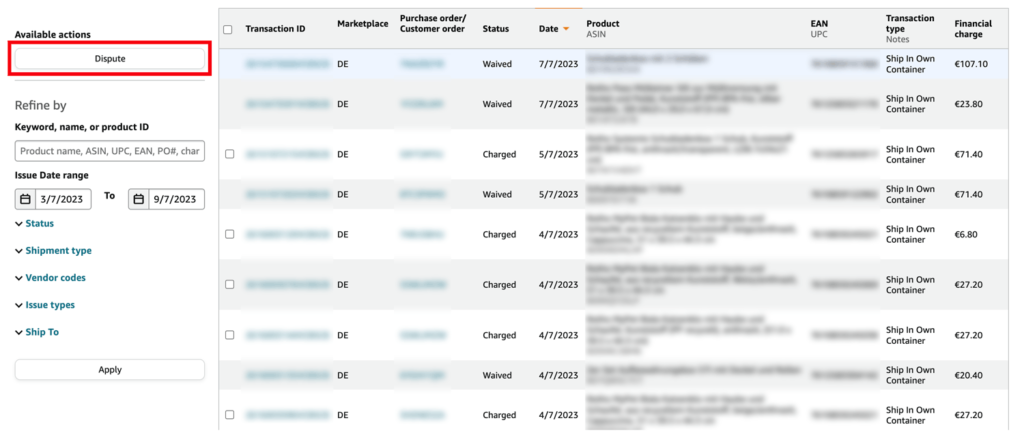Looking for answers to all your questions about Amazon vendor chargebacks? You’re in the right place!
Amazon is known for its strict process requirements for brands selling on its marketplace. They aim to ensure efficient operations and timely order fulfilment for end customers.
However, the enforcement of these rules is a source of friction between Amazon and its vendor base. That’s because the retailer issues so-called penalty chargebacks for violations against many of its policies.
In this post, you’ll learn what chargebacks are, which types of vendor penalties exist, and how to dispute them in Vendor Central.
This guide will cover:
- What Amazon chargebacks are
- How to review chargebacks in Vendor Central
- The types of vendor chargebacks
- Overview of Amazon chargeback fees
- How to dispute chargebacks with Amazon
What are Amazon chargebacks?
Chargebacks are penalties Amazon issues to vendors when they violate operational process requirements. Examples include mislabeling cartons or failing to deliver products to the Amazon warehouse on time.
Chargebacks exist because each process defect leads to small inefficiencies that result in additional costs for the online retailer. These often result in overtime for employees, longer processes, or the need for more staff.
Some vendors accept chargebacks as a cost of doing business with Amazon. But the penalties are rather meant as an incentive for brands to change their existing processes and adapt to Amazon’s requirements.
How to review your chargebacks performance
You can find an overview of your chargebacks with Amazon in the Operational Performance dashboard in Vendor Central.
To open it, simply click on Reports » Operational Performance. The console gives you an overview of the chargebacks on your account for the selected time period.
Any process defects are sorted by their status, with additional details about the rate of policy violations and any amounts charged by Amazon.

When you click on one of the chargeback types, the dashboard shows a detailed breakdown of the ASINs and POs that led to the penalty by week.

Some views show the charged versus waived amount for different types of chargebacks.
Amazon may waive penalties during the soft launch of new chargeback types or when a vendor has successfully disputed an erroneous chargeback.

For a full review of your chargebacks, Amazon also offers a detailed breakdown by marketplace and purchase order IDs in Vendor Central.
To access it, simply click on the shown chargeback amount. The resulting view lets you export and download the full report from the chargeback portal.

Types of Amazon chargebacks
Now that we have the basics of chargebacks out of the way, let’s take a closer look at the types of penalty charges in Vendor Central:
1. ASN Accuracy
ASN stands for Advanced Shipping Notification and is a virtual notification message that contains relevant information about your shipment’s contents and carrier tracking information prior to delivery.
As a vendor, you must send the ASN before the shipment arrives at Amazon’s fulfilment centre (FC). The ASN Accuracy Chargeback applies each time Amazon receives no ASN or an inaccurate ASN via EDI.
How to avoid the ASN Chargeback:
Make sure to send the correct ASN information to Amazon before the shipment arrives at the Amazon warehouse. Work with your EDI partner to ensure your technical setup is up-to-date.
2. Carton Content Accuracy
The Carton Content Accuracy Chargeback applies when the product quantities in a carton that Amazon receives don’t match the information in the Advanced Shipping Notification (ASN).
For example, the ASN may state that there are 20 products in a carton. If Amazon receives only 15 units instead, the online retailer will issue a penalty charge.
How to avoid the Carton Content Accuracy Chargeback:
Provide accurate information in your ASN, and make sure to keep your carton content information up-to-date.
This is especially important when you launch an updated version of a product or change the size of the packs you ship to Amazon.
3. Carton Information Compliance
Carton Information Compliance Chargebacks relate to unlabelled or mislabelled cartons when Amazon receives them in its fulfilment centre.
How to avoid the Carton Information Compliance Chargeback:
Make sure all bar codes and labels on your shipped cartons are readable and printed in a large format and scannable quality.
The carton content label must show a compliant 20-digit number (GS1-128 standard SSCC or AMZNCC) as plain text and barcode, and an ASN/BOL number in text and barcode, or a full list of POs both in text and barcode.
In addition, the ASN must include the same carton-level identification (20-digit number SSCC, AMZNCC, or GTIN-14) to avoid this chargeback, along with the usual ASN required information to prevent a separate ASN Accuracy chargeback.
If you use GTIN-13/14 labels that show full box contents, ensure that a compliant GS-1 barcode is present on the box and the GTIN catalogue data is provided to Amazon via Global Data Synchronization Network (GDSN) before Amazon receives your items.
Lost in the Amazon jargon? Find all the definitions in my Amazon glossary.
4. Import Documents Late Delivery
This chargeback is triggered when your teams have not delivered trade documents within the required timeframe in a Direct Import model with Amazon.
Amazon requires these documents within four days of the departure date for ocean freight or on the day of departure for air freight.
How to avoid the Import Documents Late Delivery Chargeback:
Review your processes and submit all required import documents before the estimated ocean or air freight departure date.
5. Import PO On-Time Non-Compliance
The Import PO On-Time Non-Compliance Chargeback applies when your teams have entered an Estimated Cargo Delivery Date outside the Shipping Window given by Amazon.
How to avoid the Import PO On-Time Non-Compliance Chargeback:
To prevent this chargeback, provide an Estimated Cargo Delivery Date within the shipping window of the placed Purchase Order by Amazon.
6. Import Shipment Late Booking
Amazon issues Import Shipment Late Booking Chargebacks if you did not submit a booking at least 14 days before the Ship Window Open Date for your ocean freight or three days prior to shipping by air.
How to avoid the Import Shipment Late Booking Chargeback:
Submit your Direct Import shipment booking at least 14 days (for ocean freight) or three days (for air freight) before the Ship Window Open Date.
7. No Show
A No Show Chargeback occurs when your carrier does not show up for the confirmed delivery slot and does not cancel the confirmed appointment in advance.
Many carriers will store your shipment in their warehouse before delivering it to Amazon, especially during peak periods like the fourth quarter. They seek to consolidate orders that would otherwise be too small and expensive to ship individually.
As a result, your carrier may change the day of delivery to Amazon. Failure to cancel the original delivery appointment will result in a No Show Chargeback.
How to avoid the No Show Chargeback:
Work with your carrier partner to ensure they correctly book and cancel appointments via Amazon’s Carrier Appointment Request Portal (CARP).
8. PO On-Time Accuracy
Amazon will issue an On-Time Accuracy Chargeback if your carrier delivers order volumes outside the assigned shipping window of your confirmed Amazon PO.
How to avoid the PO On-Time Accuracy Chargeback:
Ensure you deliver all confirmed products in the shipping window assigned to your Purchase Order. This may require you to prioritise Amazon in your inventory allocation process and reduce your overall vendor lead time.
9. Oversized Carton
The Oversized Carton Chargeback occurs when you send a box to an Amazon warehouse that measures over 63.5 cm on any side unless the sellable unit itself is larger than 63.5 cm.
How to avoid the Oversized Carton Chargeback:
Ensure that each box containing more than one sellable unit does not exceed 63.5 cm on any side.
10. Overage PO Units
If Amazon receives more products than confirmed in the Purchase Order, you will receive an Overage PO Units Chargeback. For example, if Amazon orders 10 units and receives 25 units, the chargeback will be applied to the overage of 15 units.
How to avoid the Overage PO Units Chargeback:
This chargeback type is often driven by catalogue misalignments. Ensure you review and update your product catalogue data regularly.
If you’re subscribed to the Amazon Vendor Service (AVS), make sure they double-check the case pack and items per inner pack catalogue data for you.
11. Overweight Carton
The Overweight Carton Chargeback occurs when you send a box to an Amazon warehouse containing a unit that weighs more than 23 kg unless the sellable unit itself weighs more than 23 kg.
How to avoid the Overweight Carton Chargeback:
Ensure that each box containing more than one sellable unit does not weigh more than 23 kg. If you sell individual units above 23 kg, they must be packed on their own and labelled as heavy.
12. Paper Invoice
Amazon issues Paper Invoice Chargebacks whenever you send a paper invoice or submit a PDF invoice via the Contact Us form in Vendor Central.
How to avoid the Paper Invoice Chargeback:
Only send your invoices to Amazon via Electronic Data Exchange (EDI) or web-based invoicing via the “Create Invoice” feature in Vendor Central.
13. Prep Issues
If products require additional prepping to deliver them safely to the customer, Amazon will raise a Prep Issue Chargeback to your vendor account.
This chargeback is split into different subtypes, depending on what prepping the product requires:
- Bagging
- Barcode Labelling
- Bubble Wrapping
- Overboxing
- Set Creation
- Taping
How to avoid the Prep Issues Chargeback:
Make sure you deliver products in packaging suitable for delivery to the end customer. If you are unsure of the specific requirements, visit the Help Centre in Vendor Central, which details Amazon’s instructions for each product and category.
14. Rejected Delivery
The Rejected Delivery Chargeback is issued when Amazon encounters safety or compliance concerns during the delivery at its fulfilment centres.
For example, Amazon may refuse delivery if pallets are unsafely stacked with products or not properly secured.
How to avoid the Rejected Delivery Chargeback:
Ensure that your pallets are delivered in accordance with Amazon’s safety, health and hazard regulations. You can find the detailed instructions in the Vendor Manual in the Resource Centre in Vendor Central.
15. Ships In Own Container
The Ships In Own Container (SIOC) Chargeback applies to products greater than 45.5 x 34.0 x 26.5 cm or 12.3 kg and are not certified as SIOC.
Note that some products are exempt from this penalty, such as advent calendars, media products or items with hazardous materials.
How to avoid the Ship In Own Container Chargeback:
Have your teams work with your Vendor Manager and AVS to get your products SIOC certified. You can also follow steps to certify products yourself or via an ISTA-certified third-party lab.
Overview of Amazon chargeback fees
Want a quick overview of the fees associated with each chargeback type?
The following tables provide an overview of the applicable fees for suppliers in Europe and North America:
| Chargeback Type | Chargeback Cost |
|---|---|
| ASN Accuracy | 2-6% of COGS |
| Carton Content Accuracy | €0.22-€0.75 per unit |
| Carton Information Compliance | €0.14 per unit |
| Import Documents Late Delivery | €50-€150 per document per day late |
| Import PO On-Time Non-Compliance | 3% of COGS |
| Import Shipment Late Booking | 3% of COGS |
| No Show | €290 |
| PO On-Time Accuracy | 3-9% of COGS |
| Oversized Carton | €1.25 per box |
| Overage PO Units | €0.6 per unit |
| Overweight Carton | €2.73 per box |
| Paper Invoice | €5 per invoice |
| Prep Issues | €0.3-€0.78 per unit |
| Rejected Delivery | €290 |
| Ships In Own Container | €1.7 per unit |
| Chargeback Type | Chargeback Cost |
|---|---|
| ASN Accuracy | 2-6% of COGS |
| Carton Content Accuracy | $2.6 per unit |
| Carton Information Compliance | $10 per box |
| Import Documents Late Delivery | $150 per document, +$50 per each additional day |
| Import PO On-Time Non-Compliance | 3% of COGS |
| Import Shipment Late Booking | 3% of COGS |
| No Show | $50-$250 |
| PO On-Time Accuracy | 3-10% of COGS |
| Oversized Carton | $25 per box |
| Overage PO Units | 10% of COGS |
| Overweight Carton | $25 per box |
| Paper Invoice | n/a |
| Prep Issues | $0.63-$1.26 per unit |
| Rejected Delivery | 3% of COGS |
| Ships In Own Container | $1.99 per unit |
How to dispute erroneous chargebacks
Sometimes, Amazon may apply erroneous chargebacks to your account. If you believe a chargeback has been wrongfully issued, you can object to it by filing a payment dispute.
To do that, log in to Vendor Central and click “Reports” and “Operational Performance“. On the following page, click “View defect list” in the upper right corner.
The resulting overview allows you to select the transactions you want to oppose. By clicking the “Dispute” button in the upper left corner, you can submit your objection and attach any supporting documents.

Note that Amazon requires you to dispute erroneous chargebacks within 30 days after they appear in Vendor Central.
So it’s good practice to implement steps to automate or outsource the disputing process to limit your resource allocation and indirect costs on the Amazon account.
It’s worth noting that you can ask for chargeback waivers as part of your annual terms negotiations. Vendor Managers will often grant waivers with vendors new to the marketplace or if you commit to fixing the underlying process defects over a period of 12 months.
Final thoughts
Keeping track of your chargebacks is a critical task to protect your profit margins with Amazon. After all, these penalties can quickly accumulate and create hidden cost centres in your P&L.
While many brands think of chargebacks as a cost of doing business with Amazon, it’s better to view them as an opportunity to identify process misalignments with the online retailer.
However, sometimes Amazon issues erroneous chargebacks. The best way to deal with these is to automate the dispute process or outsource it to specialised service providers who can recoup these charges for you.
Questions? Ping me on Twitter.
Need help assessing your vendor performance with Amazon?
If you need help to understand your vendor performance with Amazon, get in touch. I offer tailored vendor audits to uncover your full margin potential with the online retailer.

